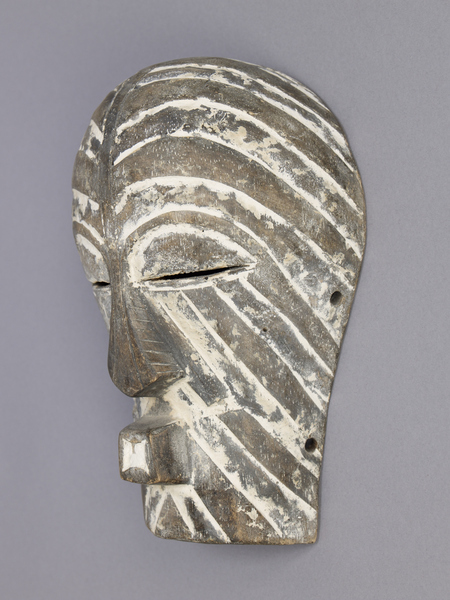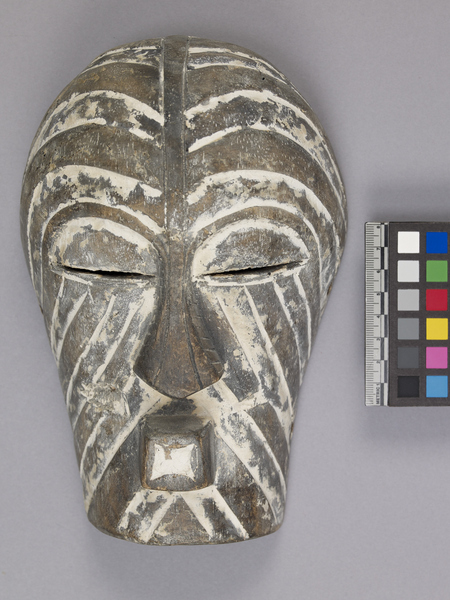Mask Item Number: 3123/20 from the MOA: University of British Columbia




Description
Wood mask. Wide incised strips have been carved diagonally over the face and in half circle patterns across the forehead. These have been filled with white lime, creating a striped pattern. From a squared chin, the face flares slightly toward the wide, rounded forehead. Down the centre of forehead is a line that meets the nose, and off of which are carved the eyebrows. Nose widens toward bottom. Eyes are thin slits cut through the wood, with large rounded eyelids above. Mouth is a protruding cube, with lime colouring the centre. Around the edge of the mask are bored five small holes, similar in size, evenly spaced. The back of mask is concave and undecorated.
History Of Use
Female kifwebe mask used and made by the bwadi bwa kifwebe society. The bwadi are a group of mystics that use masks as mediums to harness and display buchi or masende to exercise control over social tensions and retain allegiance to political leaders. Buci, or witchcraft, is an internal force that resides in the heart and stomach; masende, or sorcery, is an external force that rests in the eyes. Buci is an inherited mystical power, while masende is learned and accessible to everyone. These masks have no magical power; the bwadi who wears and uses the mask imbues it with mystical power. Kifwebe masks are traditionally carved around the time a new chief is ritually installed or when the community goes out for hunts. The carvers are called kihanga or kilongo and they traditionally make the masks out of kifwenkese and kicipicipi wood, as they have mystic properties. The masks are made in an uninhabited area, instead of in the village, as the creation of the masks is only for the carver or bwadi bwa kifwebe society members to see. Kifwebe masks can be male or female, and are performed in rituals. Male masks demonstrate and assert power through erratic movements and boisterous displays of strength; female masks emphasize fluid motions and footwork. The male masks generate magical force in relation to disorder and change, whereas the female mask appeals to the goodwill of the ancestral spirits through dance. Female masks, as a result, allow the user to contact ancestral spirits.
Iconographic Meaning
Colour symbolizes whether a mask is male or female; a dark coloured mask is male and a white mask is female. The crest of the mask indicates the level of the wearer's magical skill and experience. Based on cube shape of mouth, mask was carved under the "Mussolini" style.
Item History
- Made in Democratic Republic of the Congo
- Owned by Cornelia Hahn Oberlander before July 22, 2015
- Received from Cornelia Hahn Oberlander (Donor) on July 22, 2015
What
- Name
- Mask
- Identification Number
- 3123/20
- Type of Item
- mask
- Material
- wood and lime mineral
- Overall
- height 22.0 cm, width 15.0 cm, depth 9.0 cm
Who
- Culture
- Songye
- Previous Owner
- Cornelia Hahn Oberlander
- Received from
- Cornelia Hahn Oberlander (Donor)
Where
- Holding Institution
- MOA: University of British Columbia
- Made in
- Democratic Republic of the Congo
When
- Ownership Date
- before July 22, 2015
- Acquisition Date
- on July 22, 2015
Other
- Condition
- good
- Accession Number
- 3123/0020